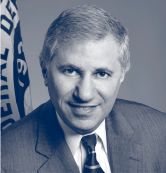2005 Annual Report
Message
from the
Acting Chairman

FDIC Acting Chairman
Martin J. Gruenberg |
I am pleased to
present the Federal Deposit Insurance Corporation's
(FDIC) Annual
2005 Performance and Accountability Report (Annual Report), a comprehensive
overview of the FDIC's programs and performance for the calendar year.
The FDIC
has been and will continue to be exceedingly well served by the professionalism
and dedication of its staff. I am honored to have the opportunity to report
the
important results and accomplishments of their activities in 2005.
I assumed my duties as Acting Chairman on November 15, 2005, upon the
resignation of Chairman Donald Powell, who, at President Bush's request,
departed
the FDIC to take charge of coordinating the federal government's efforts
towards
rebuilding of the Gulf Coast following the unprecedented natural disasters
of
Hurricanes Katrina and Rita. For the FDIC, the year will be remembered for
these
storms and their effect on Gulf Coast banks. Our top priority was ensuring
stability
and public confidence in the region's banking system. We worked around
the clock
with our fellow banking regulators, financial institutions and the public so
that
consumers and businesses could quickly regain access to needed financial services.
We actively monitored the operational condition of financial institutions in
the region
until our concerns were mitigated. And we joined other regulators in encouraging
banks to work with borrowers affected by the hurricanes. Once again, the federal
deposit insurance system served the public well by providing certainty to the
citizens
of the Gulf Coast with respect to the safety of their funds in their time of
crisis.
The region's banking industry will be dealing with the consequences of
the storms
for some time to come. In 2006, we will continue to work closely with affected
banks and consumers to address those issues.
The FDIC also continued to respond to the long term changes taking place in
the
banking industry, one that continues to consolidate and advance technologically.
Conditions in the industry have never been better, but the broader changes
underway have made our mission more challenging and important. We have
prepared ourselves well for the challenges of the future in many areas.
We continued working toward securing Congressional passage of deposit insurance
reform. This legislation, signed by President Bush on February 8, 2006, combines
the
Bank Insurance Fund and Savings Association Insurance Fund and allows the FDIC
to better price deposit insurance for risk.
We devoted substantial resources to the interagency process for implementing
the Basel II Accord in the United States. The FDIC's efforts highlighted
the need to
maintain existing U. S. Prompt Corrective Action standards under Basel II,
and to find
ways to address concerns identified by the fourth quantitative impact study
(QIS-4).
Our Center for Financial Research (CFR) co-sponsored two premier research
conferences, both attracting over 100 prominent researchers and banking
scholars from the United States and abroad. Also, 14 CFR working papers were
published on topics such as risk-measurement and capital allocation regulations.
Along with members of FFIEC–the Federal Reserve Board and the Office
of
the Comptroller of the Currency– we successfully implemented the Central
Data
Repository (CDR), a web-based system to collect, validate and manage quarterly
Call Report data. The CDR employs a new flexible data standard–XBRL (eXtensible
Business Reporting Language)–enabling Call Report data to be shared more
easily
and compared more readily with other financial data.
As part of our continuing effort to improve our response to a potential large-bank
failure, we sought comments on the best way to enhance the deposit insurance
determination process. Given the increasing concentration of banking assets
in
a small number of the largest federally - insured institutions, we identified
this as a
major priority. We are conducting a thorough review of our policies, systems
capabilities,
interagency communication procedures and workforce readiness to ensure
that we are better prepared to properly manage the failure of a large bank
or thrift.
We implemented our new Relationship Manager Program nationwide for all FDICsupervised
institutions. Designed to strengthen communication between bankers
and the FDIC, this program will enhance efficiency and increase flexibility
in
conducting examination activities.
We established the new Anti-Money Laundering and Financial Crimes Branch
within our Division of Supervision and Consumer Protection to better focus
attention
on increasing responsibilities in these areas. This Branch will address issues
related
to the Bank Secrecy Act, compliance, money laundering, financial crimes, terrorist
financing and cyber-fraud.
We continued to be a leader in helping banks to combat identity theft. The
publication
of our study, Putting an End to Account-Hijacking and Identity Theft, and a
Study
Supplement led to the issuance of FFIEC guidance in October 2005 requiring
financial institutions to use stronger customer authentication techniques for
Internet
banking by year-end 2006. We also sponsored four identity theft symposiums
around the country to educate the public and raise awareness about account
hijacking and identity theft.
We conducted a summer- long media campaign to raise awareness of the
importance of financial education in Hispanic communities across the nation
using the FDIC's free Money Smart financial education program.
As the foregoing accomplishments illustrate, the FDIC continued to serve the
deposit insurance system and the public well. In no case was this truer than
for
the citizens of the Gulf Coast who were able to rely on the guarantee of federal
deposit insurance despite the uncertainties they were facing on other fronts.
It is a testament to the strength and effectiveness of the system created over
70 years ago.
For me personally, it is an honor to serve as Acting Chairman until a permanent
successor is named.
Sincerely,

Martin J. Gruenberg